Succulents are generally easy to grow and maintain, so when it comes to indoor gardening, they are the first type of plants that comes to mind. But there are many species of succulents and they each have different care and maintenance needs, as well as different behaviors. Some may be happy in a little pot on the table, but some are better planted in hanging baskets.
The best hanging succulent varieties include hoyas, sedums like Burro’s Tail, senecios like String of Pearls, and crassulas. These succulents tend to grow long, trailing stems and are best planted in baskets and hung in the patio, terrace, or even indoors, where they get an ample amount of sunlight.
This article will talk about the best hanging varieties of succulents to grow, whether you are a beginner or an expert gardener. It also includes basic information about them, as well as tips on how to grow and care for them.
Most Beautiful Hanging Succulent: Sedum Morganianum (Donkey’s Tail/Burro’s Tail)
While it is difficult to pick the most beautiful hanging succulents because it’s purely subjective and all succulents are pretty in their own way, sedums are particularly attractive because of their fleshy, round, grey-green leaves that grow close together and cover the stems. Sedums, more specifically the Sedum morganianum, which is also called Burro’s Tail or Donkey’s Tail, look like plump green tails cascading down their pot.
Sedum Morganianum Care Guide
This beautiful and luscious trailing succulent is best planted in well-draining soil in hanging baskets because they grow long stems that spill over. These stems can grow as long as 48 inches (120 centimeters).
Donkey’s Tails love full sun or partial shade. They do love lots of sunlight, but they also don’t like extreme heat. So, if you are placing them indoors, make sure to hang them by a sunny window where they get plenty of light. If you are placing them outdoors, pick a spot that receives early morning and mid-day sun.
You need to water them thoroughly and wait for the soil to dry before the next watering. They are not cold-hardy and they are dormant during the summer.
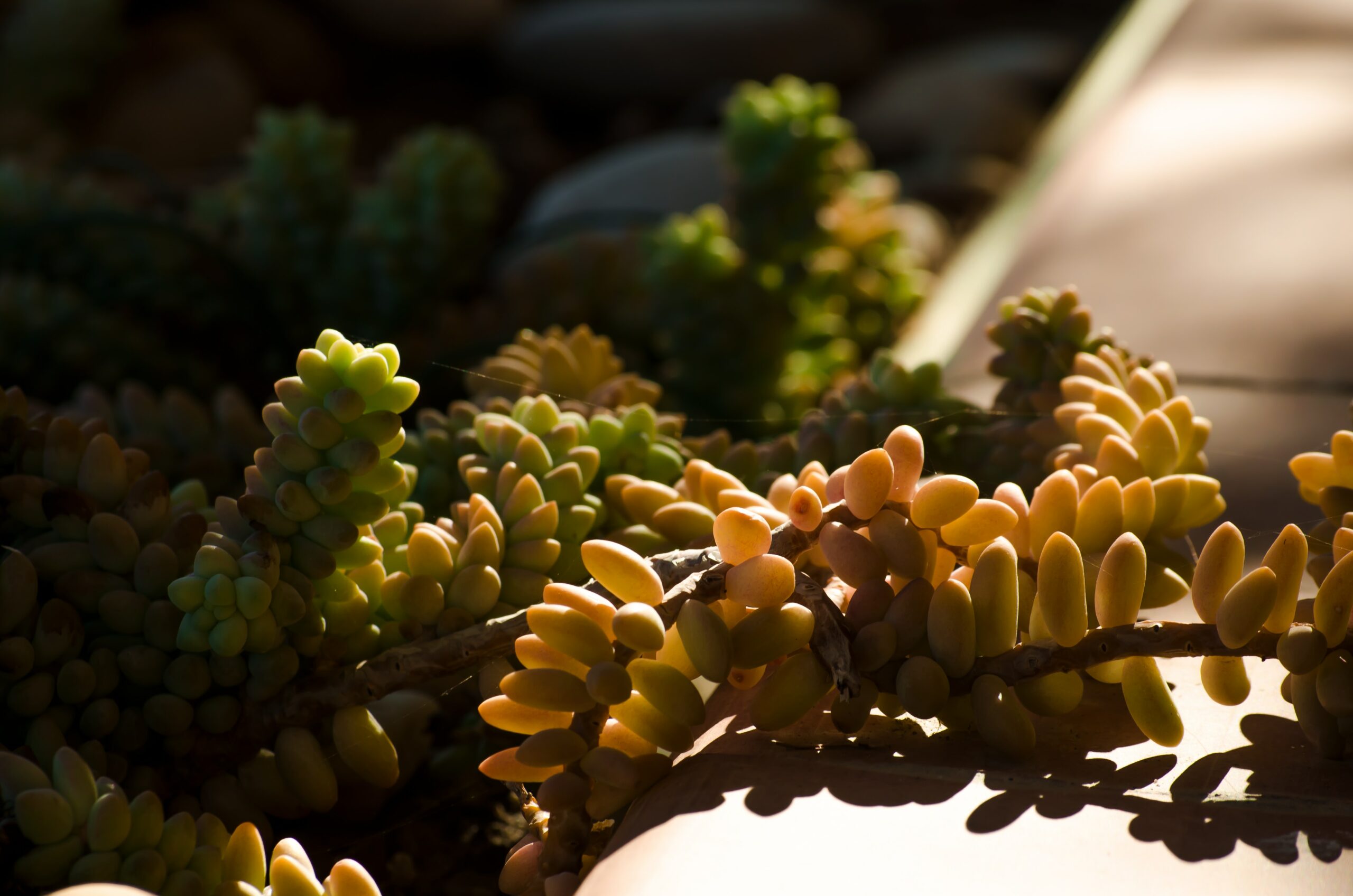
Quick Look:
Hardiness Zone: Zone 10 (minimum of 30 degrees Fahrenheit or 1.1 degrees Celsius)
Potting medium: Well-draining soil
Water: Allow soil to completely dry out in between waterings
Sun: Plenty of early morning to mid-day sun
Propagation: By leaves or cuttings
Best Flowering Hanging Succulent: Hoya (Wax Plant)
Hoyas are tropical succulents that are native to Australia and Asia. They are characterized by thick, succulent, and waxy leaves and clusters of waxy and porcelain-like flowers called umbels. That’s why they are nicknamed Wax Plant. Hoya species that are best known for their flowers are the Hoya australis, Hoya pubicalyx, Hoya archboldiana, and Hoya carnosa. The leaves of Hoya plants can vary from very succulent, to semi-succulent, to very thin.
Hoya Care Guide
Most hoyas cannot withstand direct, intense sunlight. Instead, they prefer diffused light, which you can recreate indoors by using a 50 to 80 percent shade cloth to protect the plant from direct sun. The more succulent varieties, however, like the Hoya crassicaulis, Hoya kerriii, and Hoya diversifolia, can withstand 90 percent full sun.
Hoyas are used to growing in little substrate or soil, so some people wrap them in Sphagnum moss or use coco chips for indoor display. Because of the lack of soil in some instances, the plants would need more frequent watering. Hoyas also love being rootbound, so you don’t need to report them. Or at least not as often as you would usually report other plants.
Make sure to plant your hoyas in a well-draining potting medium and a pot with sufficient drainage holes because they don’t like to sit in water. As such, let your hoyas dry out completely in between waterings.
Most hoyas do not do well in chilly temperatures. Anything below 50 degrees Fahrenheit (19 degrees Celsius) can damage the plant. So if you live in an area where it can get really cold or chilly in the winter, it is best to take the plants indoors where the temperature is more under your control. They also go semi-dormant in the winter. Hoya carnosa, which has long been cultivated, is more cold-hardy, though.
Moreover, hoyas prefer moderate to high humidity, considering that they originated from tropical and subtropical areas. The varieties with thinner leaves, meanwhile, are happy with a 60 to 80 percent humidity level. Because of this, you may want to keep a humidifier handy. And because they experience monsoon seasons in their natural habitat, they also don’t mind heavy rains at certain times of the year.
As a general rule, you can deduce the natural habitat and the cultivation requirements of your hoya variety by just looking at its leaves. For example, those with larger, thinner, and darker leaves are often more accustomed to shady and wet environments, while those with thick, succulent, and lighter-colored leaves require fuller sun and can withstand some level of drought.
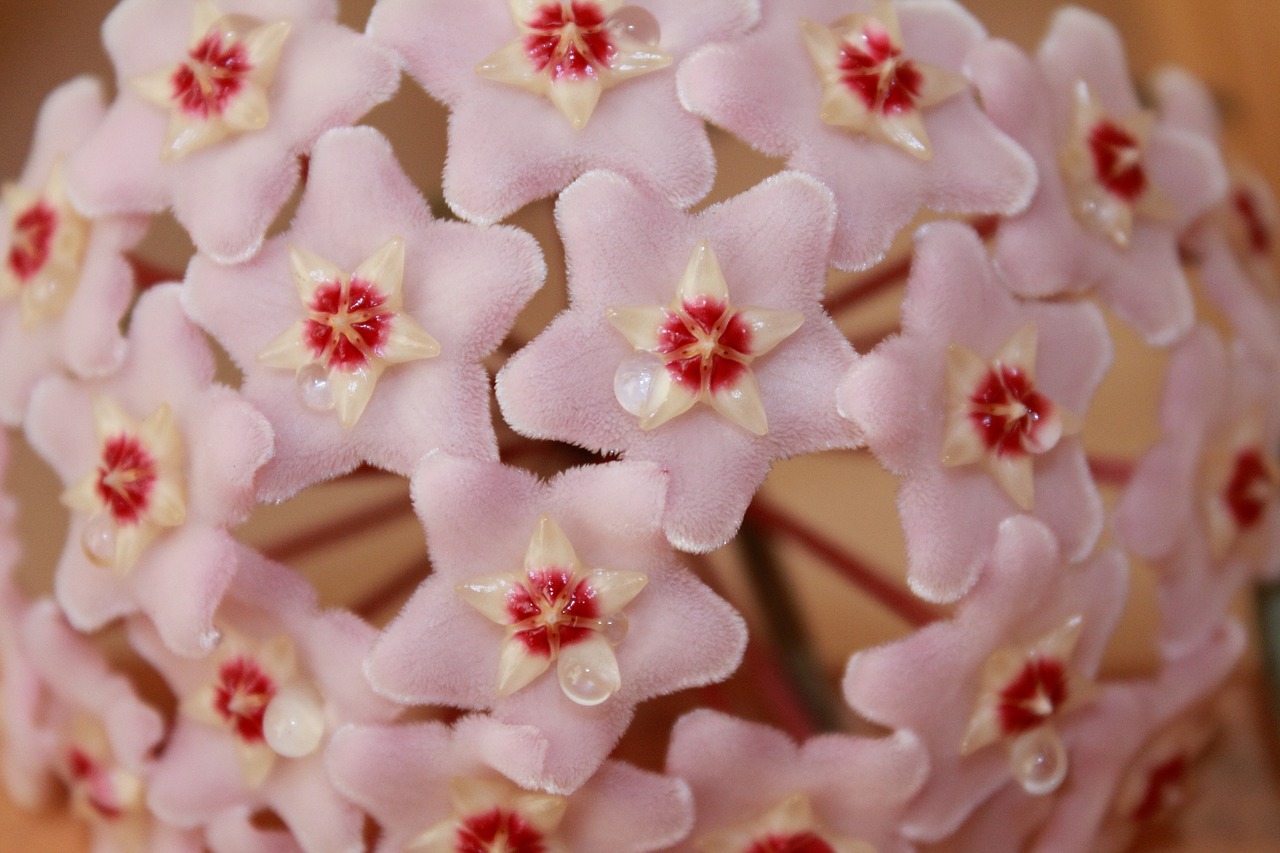
Hoyas are also easy to propagate. Sticking one- or two-node cuttings in water, in a sterile potting medium, or Sphagnum moss is most ideal. Just make sure to keep the humidity up to assist in rooting.
Quick Look:
Hardiness Zone: Zone 9-11
Potting medium: Well-draining, light soil
Water: Allow soil to completely dry out in between waterings
Humidity level: Moderate to high humidity levels
Sun: No direct and intense sunlight
Propagation: By cuttings
Best Hanging Succulents for Beginners: Senecio Rowleyanus (String of Pearls)
Senecio Rowleyanus, more commonly called String of Pearls, is a very quirky and unique-looking cascading succulent that looks like a string of, yes, green round pearls. It has a long trailing nature, and its stems can grow up to three feet long. This beautiful succulent can quickly adapt to wherever you plant it and is very easy to grow, propagate, and care for, making it a great succulent for newbies.
String of Pearls Care Guide
A String of Pearls thrives in bright, indirect light. So, if placed outdoors, they’d like to be in a shaded area with some direct morning sun or indirect afternoon sun. If placed indoors, make sure they’re near a window that receives strong natural light.
If you are keeping your String of Pearls indoors, make sure to keep the average temperature at 70 to 80 degrees Fahrenheit (21 to 26.7 degrees Celsius). During winter, keep your plant cool at around 55 to 60 degrees Fahrenheit (12.8 to 15.6 degrees Celsius). This plant is not frost-tolerant and keeps it away from drafty areas. It prefers low humidity, with humidity levels below 40 percent being optimal.
This plant needs well-draining soil and a well-draining pot that is large enough for the stems and the pearl-like leaves to fill to the brim, but not too large for the soil to stay wet far too long that would cause root rot. The String of Pearls also has shallow roots, so your pot doesn’t have to be a deep one. The crown of your pot should also be at the same level with or most an inch from the edge or rim of the pot.
String of Pearls are sensitive to overwatering, so make sure to give it just enough water, which is typically once every two weeks or once the soil is half an inch dry. During winter, reduce the frequency of watering to once a month.
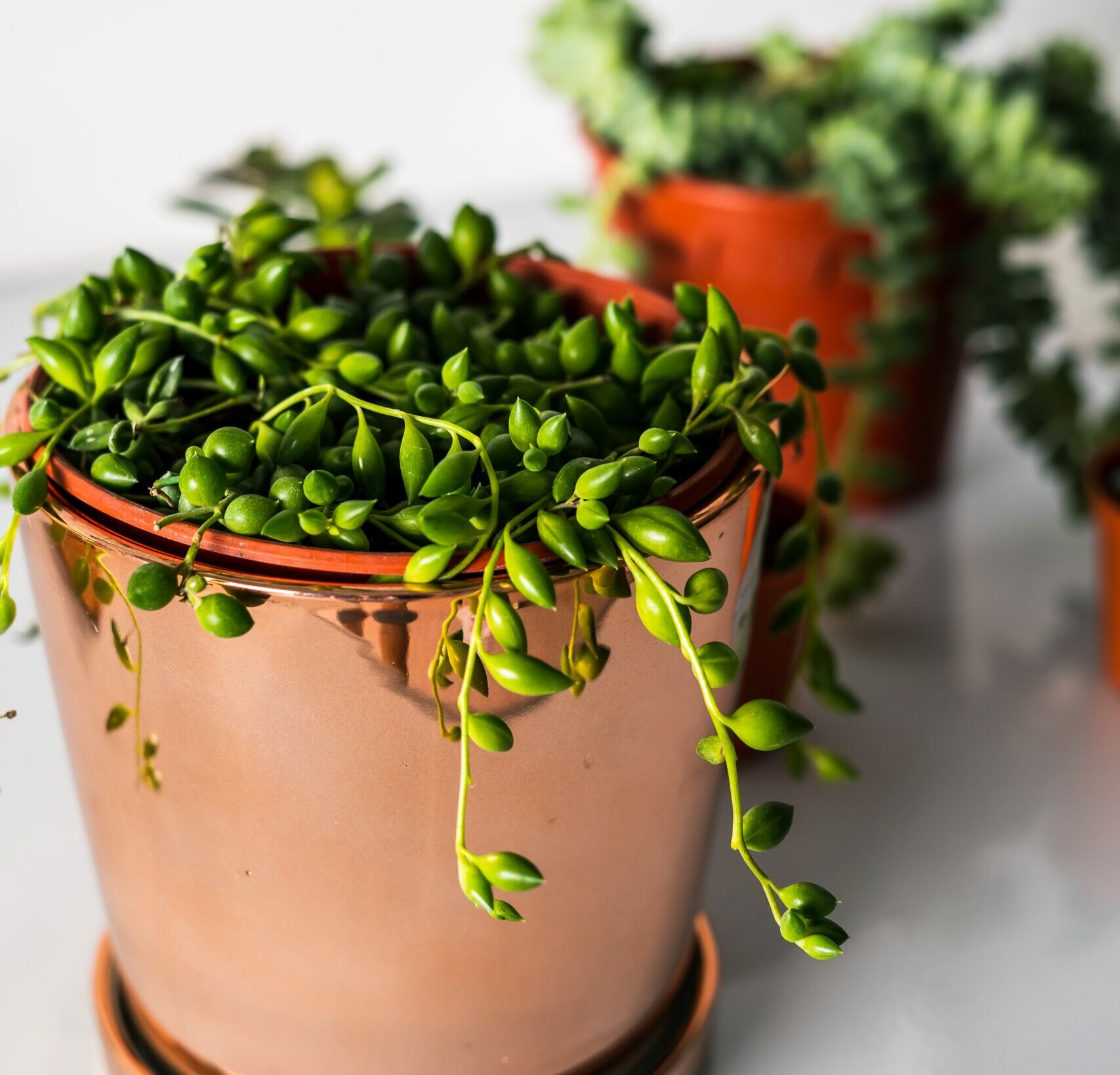
This plant is easy to propagate as new roots grow pretty quickly. You can use the cutting method.
You will know that your String of Pearls is healthy when its leaves are very round.
Quick Look:
Hardiness Zone: Zone 9-12
Potting medium: Well-draining soil in a shallow pot
Water: Once every two weeks or when half an inch of soil is completely dry
Humidity level: Low humidity levels
Sun: Bright, indirect sunlight
Propagation: By cuttings
Most Unique-Looking Hanging Succulent: Crassula Rupestris (Baby’s Necklace)
The Crassula Baby’s Necklace boasts puffy and plum leaves that look like they are intertwined beads on a little kid’s necklace, hence the name. This unique succulent is also called worm plant, vine baby necklace, and Chinese jade. The puffy leaves are green with a reddish tint on the edges.
When mature, the Crassula Baby Necklace stays small, growing only up to 12 inches (30.5 centimeters) long. And although it is a relatively small plant, it is best planted in hanging baskets because its clumps of upright stems would spill over the rim of its pot when it gets long and heavy.
Crassula Baby Necklace Care Guide
A Crassula Baby’s Necklace would thrive in sunny areas, but it doesn’t like being exposed to the scorching heat of the sun. So it is best to place them in an area that gets plenty of morning sunlight and lots of shade in the afternoon.
Plant your Crassula Baby’s Necklace in well-draining soil. This succulent is drought-resistant, but it can also survive in cold temperatures. It particularly loves summer temperatures of 65 to 70 degrees Fahrenheit (18.3 to 21 degrees Celsius). In the winter, it can withstand temperatures as low as 50 degrees Fahrenheit (10 degrees Celsius). When it gets extremely cold outdoors, it is best to bring your Crassula inside the house where the temperature is more controlled.
Make sure to water it only when the soil is already dry to the touch. Ideally, you can water it once a week during the summer, and once in three weeks during winter. Do not allow your plant to sit in water because it is susceptible to fungal diseases. So better err on the side of leaving your plant dry rather than wet. Speaking of common diseases, the Crassula Baby’s Necklace is susceptible to mealy bugs, too.
This succulent can tolerate different humidity levels. But a moisture level of at least 80 percent will make it look healthy and lush.
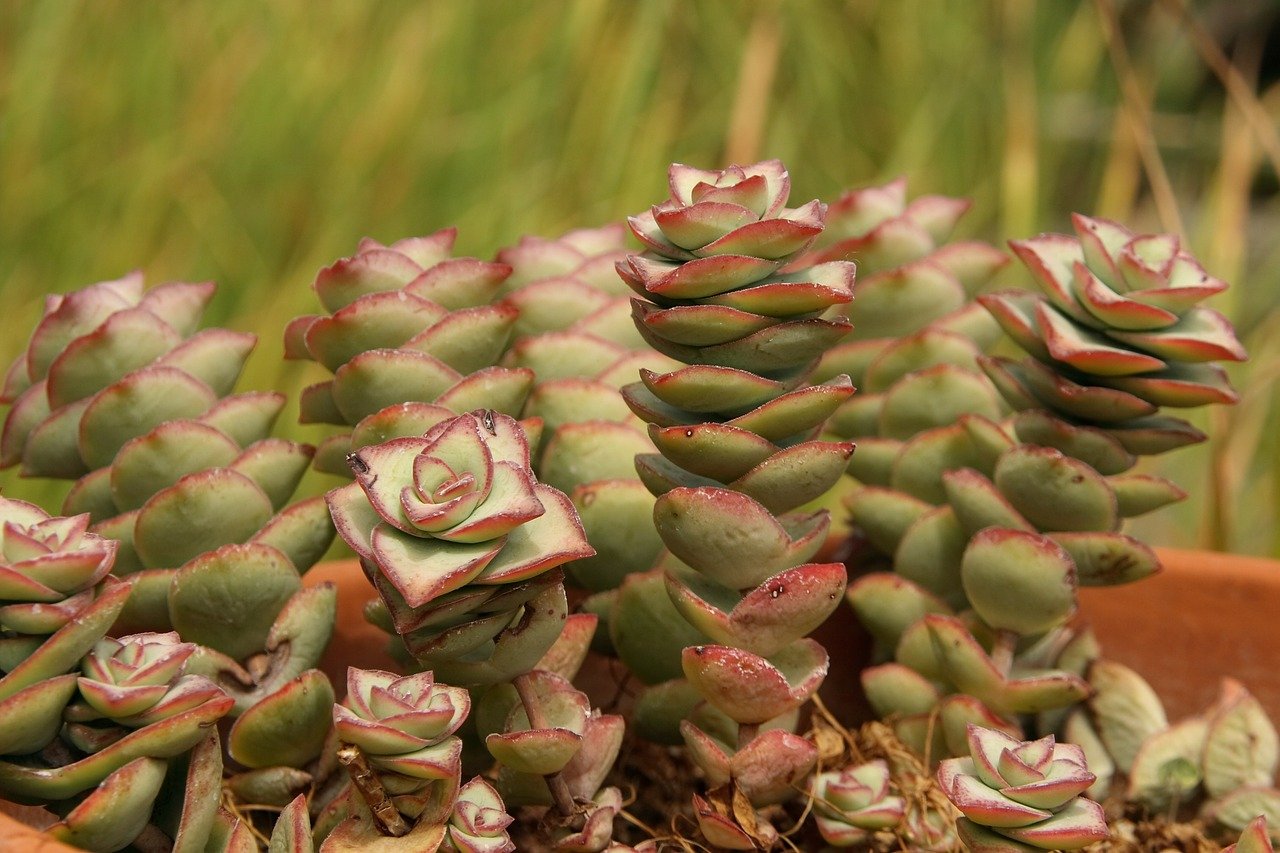
Crassula Baby’s Necklace is among the easiest succulents to propagate. You can propagate them through leaf cuttings. They can also be grown by separating and planting offsets, as well as from seeds.
Quick Look:
Hardiness Zone: Zone 9a to 10b (from 20 to 40 degrees Fahrenheit or -6.7 to 4.4 degrees Celsius)
Potting medium: Well-draining soil
Water: Water once the soil is dry, preferably once a week
Humidity level: Tolerant for different levels.
Sun: Indirect sunlight, partial shade
Propagation: By cuttings, seeds, offsets
Best Rare Hanging Succulent: Dischidia Nummularia (String of Nickels)
A String of Nickels may be getting increasingly popular these days, but it is still a hard plant to find. It’s because this unique plant is one of the rare hanging succulent varieties, and therefore also one of the best ones to add to your collection. This plant is best left in the hands of more experienced gardeners because it is rather hard to care for and is quite specific when it comes to its growing conditions.
This succulent has flat, round fleshy leaves that look like coins being strung together, thus its nickname. It is also sometimes called button orchid. Its leaves can range in color, from light olive green to a bronze-green shade. Its flowers are pale yellow or white and are very small. Some flowers can become pods filled with seeds. Its stems can grow several inches long that would spill over the edge of the pot or basket.
String of Nickels Care Guide
String of Nickels is an epiphyte, which means that it grows on tree branches in its natural habitat, just like orchids and air plants. As such, String of Nickels uses a special well-draining potting medium, like an orchid mix, coco husk chips, or a mixture of Sphagnum moss and coco husk. If grown as a houseplant, String of Nickels is planted in hanging baskets.
This succulent likes to dry out a little bit in between waterings, but do not allow it to completely dry out or its growth will be stunted and its leaves and stems will shrivel. This is why you need to plant it in a medium that helps retain moisture. Eventually, this potting mix will break down, and it will cause an air circulation problem and the plant’s roots won’t be able to receive oxygen, and it will eventually die. So always check the potting medium out and change it whenever necessary.
The String of Nickels loves filtered sunlight or bright yet indirect light at a bare minimum. Exposure to some direct sunlight is acceptable, too, as long as it’s not too long. Moreover, this plant grows best in temperatures between 40 and 80 degrees Fahrenheit (4 and 27 degrees Celsius), and they are winter-hardy in hardiness zones 11 and 12.
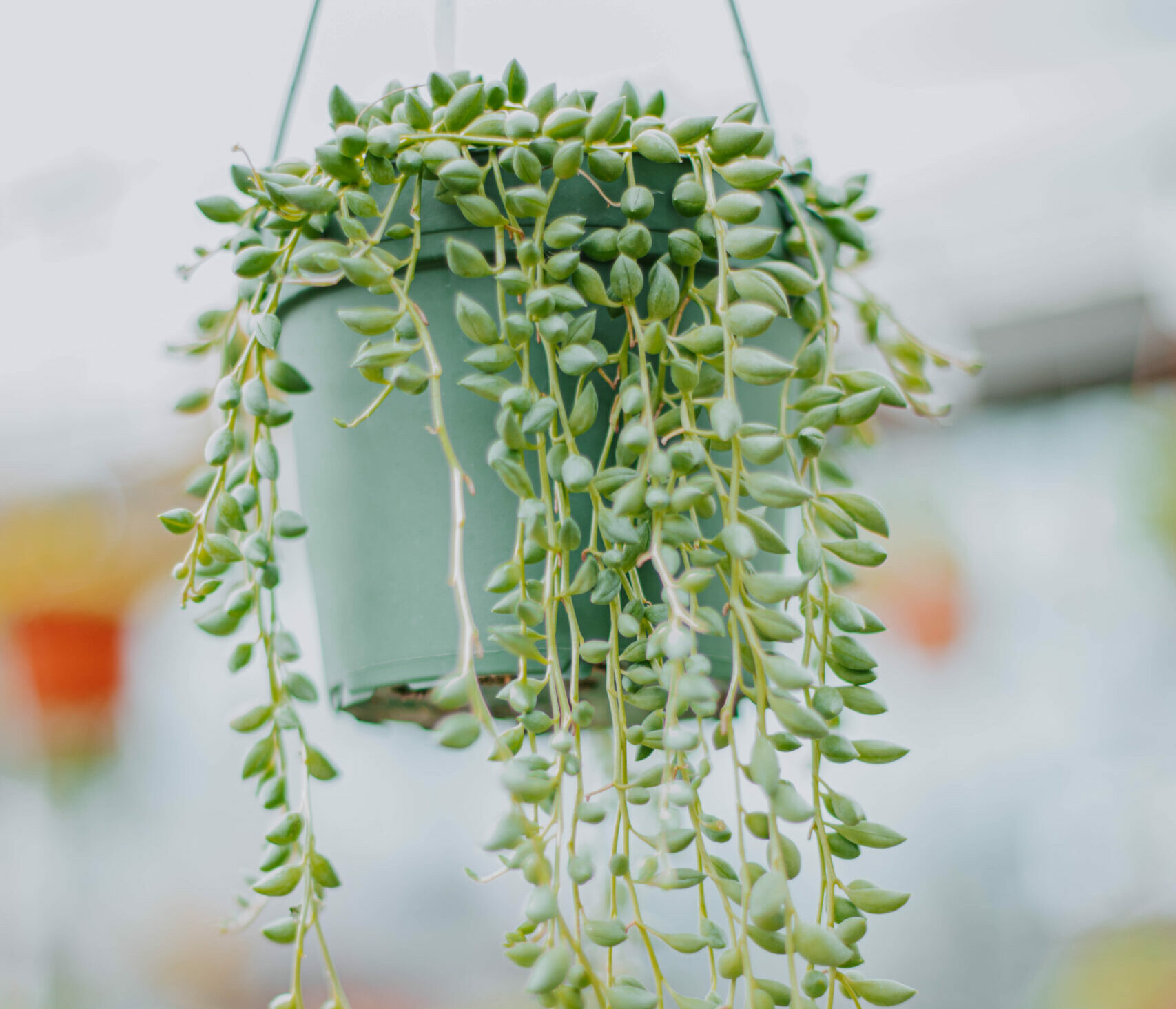
The best way to propagate this plant is through stem cuttings. Be careful when talking about the cuttings because the plant has a milky sap that could irritate your skin.
Quick Look:
Hardiness Zone: Zone 11 to 12
Potting medium: Well-draining potting mix
Water: Water once the potting medium is dry
Sun: Filtered sunlight
Propagation: By cuttings
Conclusion
There are many varieties of hanging succulents you can grow, all of them beautiful in their own way. This list is by no means definitive, and you can come up with your own list of the best hanging succulents the more varieties and species you add to your garden. In fact, outside of this list are other interesting and unique ones like String of Bananas, String of Hearts, String of Beads, String of Dolphins, String of Turtles, and many more.
Sources
- Succulent Plant Care: 14 Cacti and Succulents that Hang or Trail (With Pictures)
- Succulents and Sunshine: Sedum Morganianum Burrito
- Homestead Brooklyn: The Ultimate Hoya Care Guide
- Pistils Nursery: Hoya Plant Care: How To Grow Our Top 5 Cultivars
- Succulents Box: How to Care for String of Pearls
- Den Garden: How to Grow String of Pearls Outdoors
- Succulents Box: How to Care for Crassula Baby Necklace
- World of Succulents: Crassula Baby Necklace
- Gardening Brain: Crassula Rupestris: Baby’s Necklace Vine
- Ohio Tropics: How to Grow Dischidia Nummularia or String of Nickels
- Plant Care Today: String Of Nickels Plant Care
- My Garden Life: String of Nickels (Dischidia nummularia)
More related articles:
- Ceropegia Woodii Variegata (Variegated String of Hearts) How To Grow Them Lush
- Stapelia Gigantea (Zulu Giant): Plant Care Guide For Beginners
- Ceropegia Woodii (String of Hearts): Care, Growth and Propagation Guide


